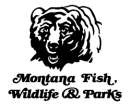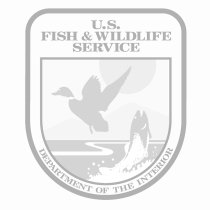Location
States
MontanaEcosystem
WetlandIntroduction
Non-native American bullfrogs (Rana catesbeiana or Lithobates catesbianus), native to eastern North America, are highly successful invaders to aquatic systems in the western United States. Bullfrogs were first observed in the Yellowstone River in 1999 in a wetland complex/pond adjacent to an inflow near the Montana Zoo in Billings, Montana. By 2005, bullfrogs were observed with increased frequency downstream at a private campground pond and in an off-channel canal adjacent to a popular angling site. These locations near Billings are at high risk for bullfrog colonization and dispersal due to complex side channels and backwaters and human modifications that create favorable bullfrog habitat, including permanent waters.
The Yellowstone River, which flows through Billings, Montana, is an undammed river. The headwaters originate in Yellowstone National Park, but farther downstream, in-stream and floodplain habitat is often modified by humans for irrigation, agriculture, flood control, and urban development. From its headwaters within Yellowstone National Park to its confluence with the Boulder River near Livingston, Montana, it is classified as a “blue-ribbon fishery” with native Yellowstone Cutthroat Trout (Oncorhynchus clarkii bouvieri). Downstream of Yellowstone, including near Billings, the fishery is primarily for wild, or self-reproducing and not hatchery-stocked, Brown Trout (Salmo trutta) and Rainbow Trout (Oncorhynchus mykiss). From here to its confluence with the Missouri River in North Dakota, the river also contains several unique fish species such as Burbot (Lota lota), American Paddlefish (Polyodon spathula), and Pallid Sturgeon (Scaphirhynchus albus). Near Billings, the Yellowstone River floodplain is also home to the native Northern leopard frog (Lithobates pipiens), Woodhouse’s toad (Anaxyrus woodhousii), and the Great Plains toad (Anaxyrus cognatus). In other western riverine and wetland systems, bullfrogs have been documented to outcompete and directly predate on native amphibians.
Key Issues Addressed
In other western riverine systems, researchers and managers have documented cases of non-native bullfrog populations that, once established, negatively impact native aquatic communities. Non-native bullfrogs have the potential to readily disperse across the landscape, have high fecundity, carry chytrid disease, and are voracious predators of native species of reptiles, amphibians, fishes, and even birds. Bullfrogs in arid western landscapes like those of southern Arizona outcompete and directly consume native aquatic species in smaller, seasonal water bodies with warm temperatures, effectively eliminating species like the endangered Chiricahua leopard frog (Rana chiricahuensis). In contrast, the Yellowstone River system contains persistent, year-round water with lower water temperatures in the fall, winter, spring and early summer. Side-channels and backwaters to the mainstem get much warmer in the summer. This may also be a challenging environment for bullfrogs, as winter air temperatures are often below freezing, and lower-flow habitats can freeze over. Spring snow melting events can also result in periods of high flow and flooding.
Managers are concerned about potential impacts of bullfrogs in the Yellowstone River due to this unique set of environmental conditions. As such, scientists from the United States Geological Survey (USGS) Northern Rocky Mountain Science Center researched ecological factors that facilitate bullfrog spread in the Yellowstone River to inform future control options. In 2010, the Montana Natural Heritage Program conducted preliminary work to access the extent of bullfrog spread throughout the Yellowstone River basin. Prior to 2010, there were ten documented bullfrog locations, yet no thorough habitat surveys had been conducted, so the severity and persistence of bullfrog populations was unknown to managers.
Project Goals
- Take inventory of non-native bullfrogs with presence/absence surveys in the Yellowstone River near Billings, Montana
- Document environmental conditions in locations with known bullfrog populations
- Track the spread of bullfrogs and their impacts on native species
- Test bullfrog suppression methods to identify effective control strategies
Project Highlights
- Systematic Surveys:Montana Natural Heritage Program initially conducted visual encounter surveys (VES) and calling surveys at 34 sites in 2010. Surveys became more systematic as the number of surveyed expanded to over 100 sites by the later project team in 2013. Surveys in 2012-2016 also included habitat measurements such as water temperature, depth, vegetation cover, and dissolved oxygen.
- Detecting Spread: Evidence for bullfrog breeding (presence of egg masses or tadpoles) was initially found in 12 sites in 2010. In 2013, evidence was observed at 58 sites along 107 km both upstream and downstream of the initial bullfrog detections near Billings.
- Habitat Modeling: The project team used a modeling approach to examine bullfrog site occupancy and colonization relative to habitat descriptors (e.g. high human use and access, human-modified conditions, and permanent waters) and covariates collected during site surveys (e.g. water depth and vegetation).
- Winter Movement: The project team conducted a small telemetry study with 20-25 bullfrogs equipped with telemetry antenna to determine where these bullfrogs moved and the types of habitat they occupied during winter months.
- Non-Native Aquatics Treatment Techniques: Multiple field techniques were used to remove bullfrogs at various life stages from sites identified with bullfrog breeding. These included seine netting, hand netting, pellet guns, dewatering, and backpack electrofishing. In 2011, laboratory tests were also conducted to determine CO2 lethal dosages for bullfrog tadpoles. In the lab, 371mg CO2/L of water were needed for 50% tadpole mortality and 549mg CO2/L of water for 99% tadpole mortality. The dosage results were not applied in the field, but established baseline thresholds that can be applied in the future.
Lessons Learned
Habitat Drivers: A modeling approach revealed that water depth and emergent vegetation best predicted bullfrog breeding at surveyed sites, while water depth and public site access best predicted bullfrog occurrence at any life stage.
While non-native aquatics management in undammed rivers often focuses on restoring natural flows, for undammed rivers like the Yellowstone maintaining natural flow variation may help to control non-native species like bullfrogs. The project team found evidence of bullfrog reproduction at a site level and declining adult bullfrog presence during the last two years of monitoring, when river peak discharge was below average and less wetted habitat was available. The findings of this study were somewhat counter-intuitive to the project team: Close proximity of a site to an off-channel, permanent water source was necessary for bullfrog success. Control efforts can therefore take into account boom and bust cycles of bullfrog populations during low- or high-flow years, and target control efforts during seasonal periods that are difficult for bullfrog survival. Non-native management in large riverine systems with hundreds of river miles involves different strategies rather than isolated ponds, as is the case with ongoing bullfrog control in southern Arizona. Direct removal efforts in the Yellowstone River are also necessary to control future impacts on native species.
Bullfrogs were often present in human-modified habitats and near publicly accessible sites. Increasing public outreach and education could be an effective method to prevent future spread and support control efforts for bullfrogs. Yet, bullfrogs are difficult to control in large systems like the Yellowstone River due to habitat complexity, flow regimes, and the difficulty of accessing remote field sites.
Although some sections of the river freeze over during winter, other sections of hyporheic (permanently saturated soil beneath the stream bed) backwaters and side channels do not freeze. As the Yellowstone River flows vary throughout the year, persistent deep waters enable young bullfrogs to survive drying conditions during summer. In 2016-2017, drought conditions with low flows and portions of intermittent floodplain habitat led to contractions of bullfrog populations. During these years the project team found either concentrated bullfrogs in small ponds or backwaters, or no bullfrogs at all, which suggested that bullfrogs moved into deeper water in the main river. The project team surveyed several sites during both summers which had previously supported bullfrogs, yet found them to be absent during these dry conditions. The team found a lack of suitable habitat for breeding and observed increased predation evidence, including from herons and raccoons. In contrast, during high flow years, deep waters may serve as a refuge from high flows. In winter, deep pools enable bullfrogs to survive freezing surface temperatures. The telemetry study revealed that tagged bullfrogs overwintered in a series of ponds in off-channel habitats with no movement to the main river. Nine or ten of these bullfrogs aggregated in one 5m section of pond.
The more locations the project team surveyed, the more bullfrogs they encountered. Due to limited funding, as the project team found more bullfrogs they focused on detecting bullfrog presence rather than attempting to quantify bullfrog impacts on the Yellowstone River. They demonstrated that traditional field survey methods like VES are still very useful. Bullfrogs are easy to find as tadpoles, easy to identify in this system, and their calls are easily heard during summer. Finding eggs and tadpoles provides clear evidence of successful reproduction.
Next Steps
- Long-Term Efforts: Determine how to prioritize future control efforts with limited funding. Managers and researchers must focus on long-term eradication actions that will prevent recolonization of bullfrog populations.
- Targeted Control: Match control efforts to bullfrog population variability. The project team plans to key into sites where bullfrogs persist during boom and bust cycles, e.g. target during drought years with low flow when populations are isolated to areas with persistent surface water, to find source populations that contribute disproportionately across the Yellowstone River system. If researchers can find these sites, then they can determine if prioritization would have a greater management impact.
- Bullfrog Genetics and Transport by Humans: Expand genetic work to determine if bullfrogs in the Yellowstone River system were introduced from one source versus multiple introductions over time, aided by people. The project team conducted genetic samples in five to six different watershed networks throughout Montana, and preliminary results show that each population is different. This suggests that people are likely not moving bullfrogs among watersheds.
- System Movement: Use novel molecular tools like population genetics and environmental DNA to better understand how individual bullfrogs disperse within systems like the Yellowstone River in order to implement more effective and targeted control efforts in the future.
Funding Partners
Resources
- USGS Project Page: American bullfrog suppression in the Yellowstone River floodplain
- USGS Program Overview: Western Waters Invasive Species and Disease Research Program
- Abbey-Lambertz et al. (2014). “Suppressing bullfrog larvae with carbon dioxide.” Journal of Herpetology 48(1): 59-66.
- Flynn et al. (2017). “Introduced American bullfrog distribution and diets in Grand Teton National Park.” Northwest Science 91(3): 244-256.
- Kamath et al. (2016). “Genetic reconstruction of a bullfrog invasion to elucidate vectors of introduction and secondary spread.” Ecology and Evolution 6(15): 5221-5233.
- Sepulveda et al. (2012). “Aquatic invasive species: lessons from cancer research.” American Scientist, 100(3): 234-242.
- Sepulveda et al. (2015). “Invasion of American bullfrogs along the Yellowstone River.” Aquatic Invasions 10(1): 69-77.
- Sepulveda, A.J. and M. Layhee. (2015). “Description of fall and winter movements of the introduced American Bullfrog (Lithobates catesbeianus) in a Montana, USA, pond.” Herpetological Conservation and Biology 10(3): 978-984.
- Sepulveda, A. J. (2018). “Novel application of explicit dynamics occupancy models to ongoing aquatic invasions.” Journal of Applied Ecology 55(2): 917-925.
Contacts
Adam Sepulveda, Research Zoologist, Northern Rocky Mountain Science Center, U.S. Geological Survey: asepulveda@usgs.gov
Case Study Lead Author
Alex Koeberle, CART Research Specialist, University of Arizona: akoeberle@arizona.edu
Suggested Citation
Koeberle, A., L. (2020). “Researching Bullfrog Establishment Pathways and Control Techniques in the Yellowstone River, Montana.” CART. Retrieved from https://www.fws.gov/project/bullfrog-establishment-pathways-and-control-techniques.







